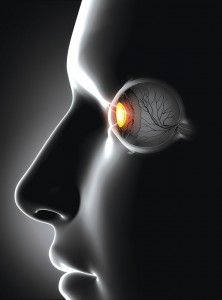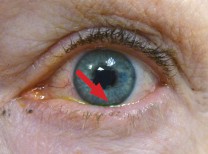
Eye vessels help determine the health of other vessels throughout the body.
They say the eye is the window to the soul. While this may indeed be the case, what I see when I peer into a patient’s eye (and I have seen a lot of eyes in my career), is essentially a map to an individual’s health.
When your doctor dilates your eye to examine the retina, many things about your health can be determined. The retina blood vessels are the only vessels in the body that can be directly viewed. No dye studies or x-rays are needed. All that is required is a skilled eye care specialist and the right tools for viewing. The health of the vessels in your eyes are often an indication of the health of the vessels throughout your body. For example, if I were to see scattered hemorrhages or deposits of cholesterol along the vessel path, it would be an indication that you likely have uncontrolled diabetes or high blood pressure. Narrowing of the arteries can be seen in the retina and indicates that your hypertension is damaging the small vessels throughout your body putting you at risk for vision loss, kidney failure, stroke or heart disease.
These findings are not always initially associated with vision loss, but they may lead there if the conditions are not treated. When this information is available to your medical team, it is valuable in setting treatment goals and monitoring treatment success. It is not uncommon to see these vessels heal right before our eyes when a patient improves their blood sugar or blood pressure.
It is not uncommon that a person newly diagnosed with Type 2 diabetes may have had the disease, undetected, for many years. A comprehensive assessment of the eyes, especially the retina blood vessels, can help determine if damage has already occurred. This is helpful in determining your course of treatment, target blood sugar level, and recommended frequency of follow up to prevent further damage to your body.
Yes. All of this can be seen in your eyes!
There are other conditions that affect your entire body which are often first detected because of eye changes. Sudden onset of vision loss in a younger patient can reveal optic nerve swelling associated with multiple sclerosis. Inflammation of the retinal blood vessels may be a sign of inflammatory disease such as rheumatoid arthritis and lupus, and can result in vision loss, light sensitivity and eye pain.
Annual dilated eye exams after the age of 50 can not only detect the onset of eye conditions, but can be a tool in diagnosing diseases affecting your entire body. Incorporating these exams into your health care plan may be more beneficial than you ever knew.
Dr. Harrison is a vitreoretinal specialist with Coachella Valley Retina in Rancho Mirage and can be reached at (760) 895.1993.











































Comments (0)